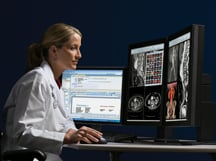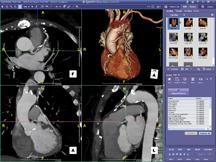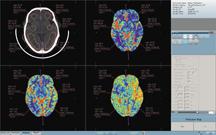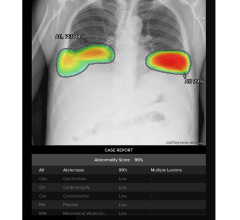
Carestreams PACS is Waddo compliant, enabling underlying streaming technology to quickly deliver data.
As radiology workflow needs change, so too do PACS. From servers to software, PACS has moved from a thick-client solution with proprietary coding and dated software to a standards-based, open architecture system using off-the-shelf hardware.
PACS vendors continue to introduce new solutions that are “Web-based.” Yet, what does Web-based PACS really mean to end users, how does it impact functionality and workflow, and will it become the dominant model for PACS solutions?
Wet feet
Did technology change radiology workflow or was it the other way around?
As the story goes, radiology first got its feet wet with Web-based PACS in 1997, when the FDA declared the FCR Fuji Computed Radiography DMS CRT Image Console HI-C654 Multimodality Display System for Networks (FUJIFILM Medical Systems USA) to be “substantially equivalent” to a legally marketed predicate device. Not long after, several other Web PACS emerged, including Amicas, Dynamic Imaging (currently GE Healthcare Centricity PACS-IW) and Stentor (now Philips iSite PACS).
What does Web-based PACS really mean? Web-based systems run within the Web environment. The ‘client’ is an Internet browser and is responsible only for displaying the user interface; none of the application runs on the client side and none of the processing is done there either.1
Al Dyer, marketing manager, PACS, at Agfa Healthcare, describes the Web-based concept as turning a browser, such as Internet Explorer, into a client. “It is an application that uses different Web technologies in a very open manner, regardless if the user is on a PC or a Mac, using Linux or Windows for the OS.” The concept is a very inclusive solution that is open to different platforms, he says.
Virtual radiology changes the game
The explosion of Web-based PACS is closely tied to the virtual radiology environment trend, notes Joe Maune, business manager, Healthcare Information Solutions, Carestream Health. “Five years ago, most of the diagnostic workstations were situated in the radiology department.”
Today, many sites are decentralizing radiology reading and enabling radiologists to read remotely. Supporting this environment with a thick-client solution requires more capital equipment investment and supporting IT staff. “Many of the first Web viewers only offered very rudimentary tools, which works for a referring physician, but not a radiologist,” he added.
It is important for Web-based PACS to have the ability to operate in a mixed environment, says Shelly Fisher, president, BRIT Systems. “Early on, many Web-based servers were Linux because the OS was free. Companies just had to build their own PC,” she said. In fact, Fisher believes that in the future, the OS will be less important than the toolkits as users evaluate different Web-based PACS.
One benefit of a Web-based PACS is unlimited distribution of underlying applications. In the case of Fuji’s Web-based Synapse, Jim Morgan, director of marketing, Network Systems for FUJIFILM Medical Systems USA, said, “Users access the same software regardless of where they are located. For our customers, this translates to a PACS that is easier to deploy, easier to update and easier to use.”
But what is most important to customers, according to some experts, is a robust front-end viewer. “The viewer should provide access to every image within one to two seconds, and offer the same user interface for everyone,” said Brad Levin, vice president of GE Healthcare, Dynamic Imaging Solutions Group. Since the application resides on a standard operating system, such as Microsoft, the architecture and infrastructure is not as complex and requires less technical intervention by the facility’s IT department than a thick-client server solution.
“Daily management is
inherently less intrusive,” added Levin. “So PACS administrators can spend more time focusing on new users and referring physicians, enhancing protocols or rolling out new sites.” Off-the-shelf hardware is typically used for Web-based PACS, often leading to a faster return-on-investment for the facility, he says.
Web-based toolkits
For many solutions, ActiveX (Microsoft) is the applet that enables certain functions, such as the imaging algorithm. The use of http protocols then enables data to stream directly to the desktop.
“There are different technologies for distributing large datasets to the desktop,” added Morgan, “so buyers should inquire on the use of compression technologies and the speed of the data as they evaluate different solutions.”
To provide users with the full functionality of a client-server PACS, GE Centricity-IW uses Apache Tomcat, which is an implementation of the Java Servlet and Java ServerPages technologies, as its Web server. The Web viewer is designed with C++, providing users with various ways to launch the software, while a Microsoft SQL database server supports nearly any network configuration (SAN, NAS, DAS, etc.), says Levin.
Agfa’s IMPAX uses Waddo for access to static and dynamic DICOM objects. Yet, Dyer believes server-side rendering will lead to the “democratization of image rendering.” Rather than sending or downloading an application and image, clinicians will point to an image set residing on the server. The necessary technology to render the images remains on the server, which renders the image back to the user’s viewer. “This technology is particularly useful when accessing large imaging files, such as a 1,000-slice CT study,” he added.
While Carestream’s PACS is also Waddo compliant, the company has developed an underlying streaming technology that “intelligently provides the content as quickly as possible, without requiring the user to wait for the entire data set,” said Maune. For example, if the user is interested in slice 650 in a 2,000-slice CT study, the slices surrounding slice 650 are streamed to the desktop first, enabling the user to begin viewing the study as quickly as possible.
The Google Web Toolkit (GWT) also does not require any downloads, says Fisher. According to Google’s Web site, GWT lets software developers “quickly build and maintain complex yet highly performant JavaScript front-end applications in the Java programming language.”2 As a result, BRIT programmers have developed an AJAX application across all major browsers for the company’s newly-launched Web-based PACS, Roentgen Files II. “The real benefit is that AJAX allows real-time update of information from the server to the viewer without the need to either refresh or update the screen,” said Fisher. As for the OS, Fisher says her company has started using Ubuntu for a more user-friendly Linux solution that is also easier to install.
What it means to the user
So what does Web-based PACS mean for the user?
One key advantage is that imaging data is online, all the time, accessible from anywhere, says Kim Baldwin, PACS administrator, South Jersey Radiology Associates. “The impact on workflow is significant,” noted Baldwin, “as users no longer wait for the system to pre-fetch patient studies.” Another benefit is that “multiple users can view images simultaneously, leading to more consultations between radiologists, specialists and referring physicians.” A warning notifies the users that more than one person is viewing the image(s), she adds.
The real benefit for Baldwin is that she can monitor her facility’s Centricity PACS-IW from virtually anywhere, including home. Just as radiologists can read from virtually any location, Baldwin can manage remotely. With eight locations, it is impossible for Baldwin to be on site at all times. She said, “I can troubleshoot or help a technologist delete, merge or split a study from home or another site. In fact, 98 percent of our issues can be fixed remotely, so we don’t need to keep additional staff on-site.”
Echoing Baldwin’s point that a Web-based PACS is a solution designed for a site with limited IT resources is Rob Homan, RIS/PACS Coordinator, Joint Township District Memorial Hospital. “We have one large server in our computer room, versus 60-70 PC servers disbursed throughout the facility,” he noted. This reduces time and cost for upgrading to new software versions, which he did when his site moved from Kodak Carestream PACS version 10 to 10.2. “With a thick-client system, it would take an entire evening to load and the following day to test. Now with a thin-client solution, I can complete the same project from install through testing in less than six hours,” explained Homan. The software then updates accordingly on each thin-client without additional human effort.
With a Web-based PACS, Homan also finds that clinical display protocols specific to an assigned user will follow that user wherever he or she logs in. “Many of our radiologists cover for another hospital, so if they log into our system remotely, they have the same configuration as if they were here.” The result: Homan travels less to referring physician offices to set display protocols and, in general, spends less time with applications settings.
Multi-media PACS
Looking forward, it appears that Web-based PACS will become the preferred architecture, particularly as diagnostic imaging embraces multi-media. “We expect to see a montage of data delivered at higher speeds using better compression techniques,” said Morgan, “including video clips for dynamic studies such as angiography or echocardiography.”
Delineation of imaging studies as ‘radiology’ or ‘cardiology’ will continue to dissipate as the virtual desktop becomes more prevalent. Levin sees the need for a single viewer for all types of studies, using the same interconnected infrastructure that provides clinicians with a single, longitudinal patient jacket. “Everything will come full circle and we will see the consolidation of department PACS into one centralized system,” he added.
Likewise, archives will continue to migrate to a centralized, enterprise solution, said Dyer. “As with Google, viewers will connect directly to that data center, allowing clinicians and patients to view data,” he added, “using XML and html for the presentation of studies.”
The use of ‘cloud computing’ will continue to grow, says Fisher, where the underlying technology is not a server, rather multiple servers that manage the storage of data across multiple systems. “Just as we have redundancy of data, we will see redundancy of the application, removing single points of failure to ensure continued accessibility by users,” she said. Fisher also believes the “new PACS world” will be much like the “Google world,” with systems talking to each other.
Additional clinical efficiencies, such as the availability of 3D over the Web, will continue to take hold, particularly as workstations become more integrated, notes Maune. “We expect to see greater utilization of hosted storage solutions, an ideal solution for smaller sites such as doctor offices,” he said. Hosted solutions not only reduce IT management expense at the healthcare facility, but also provide disaster recovery and business continuance solutions.
The result will be the proliferation of health information across the Web, which may make it easier to access a patient’s complete electronic medical record (EMR). As the U.S. federal government seeks ways to reduce the cost of healthcare and, simultaneously, provides incentives for healthcare providers to implement EMRs, advisors and analysts should examine the growth and success of Web-based PACS as a model for a lower cost, highly accessible, Web-based EMR.
References:
1. Wood, Simon P. Web-based v. Web-enabled LIMS: What is the Difference? STARLIMS. Oct. 2007.
2. Available at http://code.google.com/webtoolkit




 April 11, 2024
April 11, 2024 








